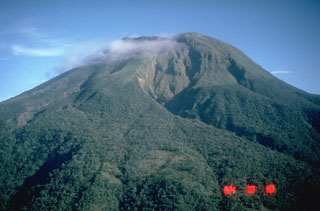Report on Bulusan (Philippines) — 16 April-22 April 2025
Smithsonian Institution / US Geological Survey
Weekly Volcanic Activity Report, 16 April-22 April 2025
Managing Editor: Sally Sennert.
Please cite this report as:
Global Volcanism Program, 2025. Report on Bulusan (Philippines) (Sennert, S, ed.). Weekly Volcanic Activity Report, 16 April-22 April 2025. Smithsonian Institution and US Geological Survey.
Bulusan
Philippines
12.769°N, 124.056°E; summit elev. 1535 m
All times are local (unless otherwise noted)
The Philippine Institute of Volcanology and Seismology (PHIVOLCS) reported increased seismicity at Bulusan. Seismicity recorded from 0300 on 12 April until 2200 on 21 April consisted of 94 weak volcano-tectonic earthquakes indicating rock fracturing, another four low-frequency volcanic earthquakes indicating fluid movement. The earthquake locations were within 20 km depth, with about half characterized as shallow. Weak-to-moderate gas emissions rose from the summit crater and active vents. The Alert Level remained at 0 (the lowest level on a scale of 0-5).
Geological Summary. Luzon's southernmost volcano, Bulusan, was constructed along the rim of the 11-km-diameter dacitic-to-rhyolitic Irosin caldera, which was formed about 36,000 years ago. It lies at the SE end of the Bicol volcanic arc occupying the peninsula of the same name that forms the elongated SE tip of Luzon. A broad, flat moat is located below the topographically prominent SW rim of Irosin caldera; the NE rim is buried by the andesitic complex. Bulusan is flanked by several other large intracaldera lava domes and cones, including the prominent Mount Jormajan lava dome on the SW flank and Sharp Peak to the NE. The summit is unvegetated and contains a 300-m-wide, 50-m-deep crater. Three small craters are located on the SE flank. Many moderate explosive eruptions have been recorded since the mid-19th century.
Source: Philippine Institute of Volcanology and Seismology (PHIVOLCS)

